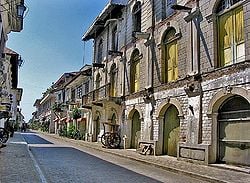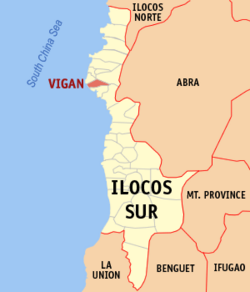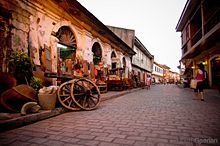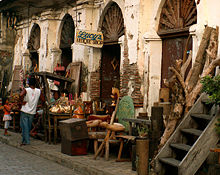Vigan
| City of Vigan Ciudad ti Bigan Lungsod ng Vigan |
|
| Vigan City | |
| Nickname: Ciudad Fernandina de Vigan | |
| Map of Ilocos Sur showing the location of Vigan. | |
| Country | Philippines |
|---|---|
| Region | Ilocos Region (Region I) |
| Districts | 1st District of Ilocos Sur |
| Barrios or Barangays | 39 |
| Cityhood | January 22, 2001 |
| Government | |
| - Mayor | Eva Marie Singson-Medina |
| Area | |
| - Total | 11 km² (4.2 sq mi) |
| Population (2007) | |
| - Total | 47,246 |
| - Density | 4,295/km² (11,124/sq mi) |
| Time zone | PST (UTC+8) |
| Area code(s) | 77 |
| Website: www.vigancity.gov.ph | |
The City of Vigan is the capital city of the province of Ilocos Sur, Philippines. According to the 2007 census, it has a population of 47,246 people. Located on the western coast of the large island of Luzon, it faces the South China Sea. Since the fourteenth century C.E., Vigan served as a key trading port with China. From the sixteenth century, the Spanish controlled the port. In 1572, Conquistador Juan de Salcedo attacked and secured the town, giving it the name Vigan after a native plant. He expanded the name to Villa Fernandina in honor of the Philip II's deceased son. Salcedo continued his conquest, attacking and subjugating Camarines, Albay, and Catanduanes.
Vigan constitutes the best example of a Spanish colonial town in the Philippines. It has become well-known for its cobblestone streets and a unique architecture that fuses Philippine building design and construction with European colonial architecture and planning. The city has played a role in the political life of the Philippines, in addition to serving as capital to the Ilocus Sur province, Elpidio Quirino, the sixth president of the Philippines, resided in Vigan. UNESCO designated the Historic Town of Vigan a World Heritage Site in 1999.
| Historic Town of Vigan* | |
|---|---|
| UNESCO World Heritage Site | |
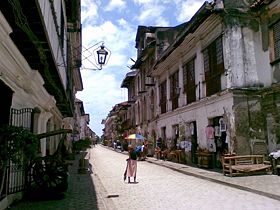
| |
| State Party | |
| Type | Cultural |
| Criteria | ii, iv |
| Reference | 502 |
| Region** | Asia-Pacific |
| Inscription history | |
| Inscription | 1999 (23rd Session) |
| * Name as inscribed on World Heritage List. ** Region as classified by UNESCO. | |
History
Chinese Traders
Vigan had been a key coastal trading post in Asia since the fourteenth century C.E.[1] China traded with Vigan, using the Mestizo River that provided a wide access to the delta. Vigan had been detached from the mainland of Ilocos Sur by the Abra River, Mestizo River, and the Govantes River. During that era, Vigan had been a peninsula, providing ready access to Chinese ships. Chinese traders brought goods from China, the South Sea Islands and throughout Asia, exchanging them for the products of Ilocos Sur, especially gold, beeswax, and produce from the surrounding mountains.
Spanish Era
From the sixteenth century, Spanish traders discovered Vigan, quickly seeing the strategic value of the town as a trading port in Asia. Governor General Guido de Lavezaris wrote King Philip II of Spain of his desire to settle the area of Ilocos Sur.[2] He reported sending conquistador Juan de Salcedo with a small company of 70 to 80 soldiers to Vigan. Salcedo departed Manila, arriving in the port city, on June 12, 1572.
When Salcedo arrived at present day Barangay "Pagpartian" (Ilocano, "butchering place"—because it is the location of the city abattoir) through the Mestizo River, he noticed the lush, green plants growing along the riverbanks. He asked a native about the name of the place. The native, not understanding Spanish, thought he was asking the name of the plant, told him that they were biga'a. Salcedo named the city "Vigan" after the plant.[3] As the city grew, and the seat of the Archdiocese of Nueva Segovia transferred to the place, it received the name Ciudad Fernandina de Vigan, in honor of King Philip II of Spain first born son of who had died in childhood. [4]
After the successful conquest of Vigan, Salcedo carried on his voyage of colonization, taking control of Camarines, Albay, and Catanduanes. As a reward for his conquests, the King of Spain gave Salcedo the area of Ylocos as his encomienda which consisted of Ilocos Norte, Ilocos Sur, Abra, La Union and a portion of the mountain province. [5]
Salcedo established Vigan as the capital of his encomienda. Two years later, in 1574, he accompanied Augustinian missionaries to Ylocos. In 1591, Governor General Gómez Pérez Dasmariñas described the status of Vigan: “The town of Vigan called Villa Fernandina has five or six Spanish citizens with one priest, a Justice, one Alcalde Mayor (Governor) and a Deputy. The King collects 800 tributes (equivalent to 3,200 subjects). During this period, the old Vigan was composed of 19 barrios."[6]
Barangays
Vigan City is divided into 39 barangays.[7]
|
|
|
Major Schools Based in Vigan
- University of Northern Philippines: the oldest State University in Northern Luzon, founded by virtue of Republic Act 4449, authored by the late Congressman Floro Crisologo
- Saint Paul College of Ilocos Sur]] (formerly Rosary College): the oldest privately-funded school in Ilocos Sur, founded by the Sisters of Saint Paul of Chartres in Vigan (but recently fully transferred to nearby Bantay)
- Divine Word College of Vigan: the second oldest privately-funded school in Ilocos Sur, founded by priests belonging to the Society of the Divine Word (SVD)
Gallery
An example of a typical "bahay na bato" seen in Vigan[8]
See Also
- Portuguese Empire
- Portuguese
- Decolonization
- Philippines
- Manila
Notes
- ↑ Resil B. Mojares. Brains of the nation: Pedro Paterno, T.H. Pardo de Tavera, Isabelo de los Reyes, and the production of modern knowledge. (Quezon City: Ateneo de Manila University Press, 2006), 255
- ↑ Emma Helen Blair, James Alexander Robertson, and Edward Gaylord Bourne. The Philippine Islands, 1493-1803 explorations by early navigators, descriptions of the islands and their peoples, their history and records of the Catholic missions, as related in contemporaneous books and manuscripts, showing the political, economic, commercial and religious conditions of those islands from their earliest relations with European nations to the beginning of the nineteenth century. (Cleveland, OH: A.H. Clark Co., 1903, vol. III), 276.
- ↑ Manuel D. Duldulao. The Filipinos: portrait of a people. (Quezon City, Metro Manila, Philippines: Oro Books, 1987), 92
- ↑ Heritage City of Vigan: History of Vigan
- ↑ Marciano R. De Borja. Basques in the Philippines. (The Basque series) (Reno: University of Nevada Press, 2005), 37
- ↑ Felix M. Keesing. The ethnohistory of northern Luzon. (Stanford Anthropological Series, 4.) (Stanford: Stanford Univ. Press, 1962), 126.
- ↑ Esperanza Bunag Gatbonton. Vigan album: memories & images of a town. (Manila: National Commission for Culture and the Arts, 2002), 3
- ↑ Paul A. Rodell. Culture and customs of the Philippines. (Culture and customs of Asia) (Westport, CT: Greenwood Press, 2002), 88.
ReferencesISBN links support NWE through referral fees
- Blair, Emma Helen, James Alexander Robertson, and Edward Gaylord Bourne. 1903. The Philippine Islands, 1493-1803 explorations by early navigators, descriptions of the islands and their peoples, their history and records of the Catholic missions, as related in contemporaneous books and manuscripts, showing the political, economic, commercial and religious conditions of those islands from their earliest relations with European nations to the beginning of the nineteenth century. Cleveland, OH: A.H. Clark Co. Template:OCLC 30266282.
- De Borja, Marciano R. 2005. Basques in the Philippines. (The Basque series.) Reno: University of Nevada Press. ISBN 9780874175905.
- Gatbonton, Esperanza Bunag. 2002. Vigan album: memories & images of a town. Manila: National Commission for Culture and the Arts. ISBN 9789718140284.
- Keesing, Felix M. 1962. The ethnohistory of northern Luzon. (Stanford Anthropological Series, 4.) Stanford: Standord Univ. Press.
- Mojares, Resil B. 2006. Brains of the nation: Pedro Paterno, T.H. Pardo de Tavera, Isabelo de los Reyes, and the production of modern knowledge. Quezon City: Ateneo de Manila University Press. ISBN 9789715504966.
- Rodell, Paul A. 2002. Culture and customs of the Philippines. Culture and customs of Asia. Westport, CT: Greenwood Press. ISBN 9780313304156.
External links
All links retrieved May 3, 2023.
| |||||||
Credits
New World Encyclopedia writers and editors rewrote and completed the Wikipedia article in accordance with New World Encyclopedia standards. This article abides by terms of the Creative Commons CC-by-sa 3.0 License (CC-by-sa), which may be used and disseminated with proper attribution. Credit is due under the terms of this license that can reference both the New World Encyclopedia contributors and the selfless volunteer contributors of the Wikimedia Foundation. To cite this article click here for a list of acceptable citing formats.The history of earlier contributions by wikipedians is accessible to researchers here:
The history of this article since it was imported to New World Encyclopedia:
Note: Some restrictions may apply to use of individual images which are separately licensed.
